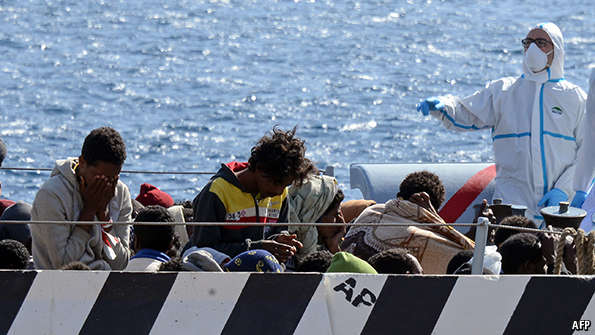
WHETHER it was the Mediterranean's deadliest refugee drowning in decades remains to be seen. But it was certainly terrible, and its political effects could spread far. One of the survivors of a refugee boat that capsized late on the night of April 18th in the waters between Libya and the Italian island of Lampedusa said that at least 700 people had been on board. Just 28 have been rescued so far. That would make it by far the worst maritime disaster in the Mediterranean since World War II.
On April 19th the Italian coast guard sounded a cautionary note on the casualty figures. The boat was just 20 metres long, and while it may have been transporting hundreds of people, it is doubtful whether even the ruthless people-smugglers who dispatch migrants from the Libyan coast could force 700 aboard a vessel of that size. By early afternoon, with 24 bodies recovered, the coast guard said the number of dead might need to be recalculated.
What is beyond doubt, though, is that the migrants crossing the Mediterranean to Europe are dying this year at an unprecedented rate. According to figures released by the Italian interior ministry after the latest disaster, 23,556 people have entered Italy irregularly by sea since January 1st. That is not a big increase over 2014, when the figure for the same period was 20,800. But the death toll, according to the International Organisation for Migration (IOM), has leapt almost tenfold. Even before the latest calamity it stood at 954.
Why? Apart from worse weather, humanitarian aid officials point to two factors. One is the suspension last October of Italy’s Mare Nostrum search-and-rescue mission. It was replaced by Operation Triton, run by the EU’s border control agency, Frontex, which has a much narrower remit to patrol Italy’s territorial waters and a budget of less than a third that of Mare Nostrum.
The second factor is that the smugglers are cramming more and more people on ever more vulnerable craft as they run short of boats. Twice this year, armed smugglers have forcibly taken back boats used to transport migrants and asylum-seekers after their passengers were rescued by other vessels—a sure sign that the boats are becoming more valuable. In the second incident, which took place last Monday, the smugglers fired shots in the air before recovering a wooden craft about 60 nautical miles (111km) from the Libyan coast.
Frontex’s executive director, Fabrice Leggeri, said last month that “anywhere between 500,000 to a million people" were ready to leave from Libya. That would not be surprising: Libya has lapsed into anarchy since the overthrow of Colonel Muammar Qaddafi in 2011. It has become an especially hellish place for sub-Saharan migrants, who report being robbed, kidnapped and confined to detention centres, where men are often beaten and women raped. But the shortage of boats suggests that a decreasing proportion of those wanting to leave for Europe will be able to do so—and those who do will face an increasingly perilous journey.
What to do? The European Union’s response so far has been remarkably languid. The latest disaster may at last spur it into action. Mr Leggeri has asked for more resources from the EU. And the leaders of member states may be now be prepared to consider a wider remit for Operation Triton. It would foolish to imagine that the migrants and asylum-seekers will stop coming. In lawless Libya and in the migrants' countries of origin—Syria, Eritrea, Somalia, Mali—the factors pushing them to gamble their lives on a sea crossing to Italy are still in place.